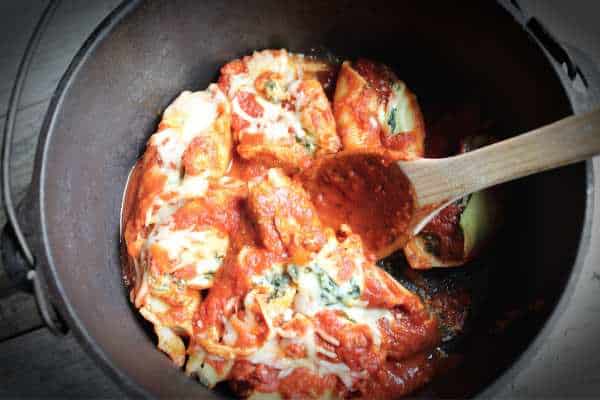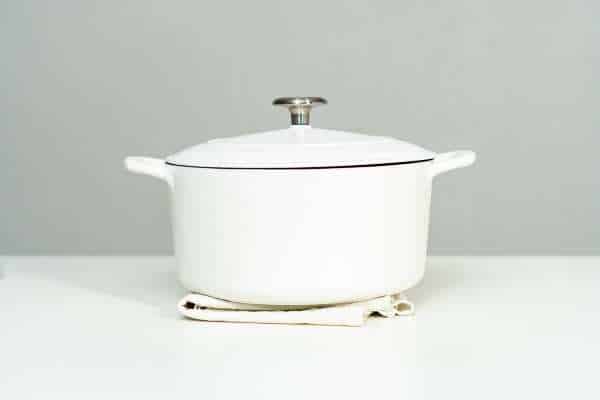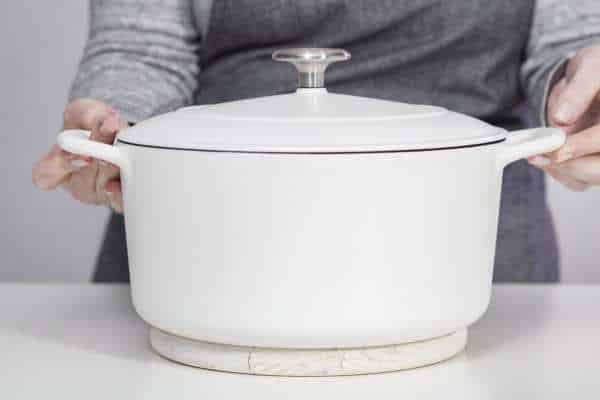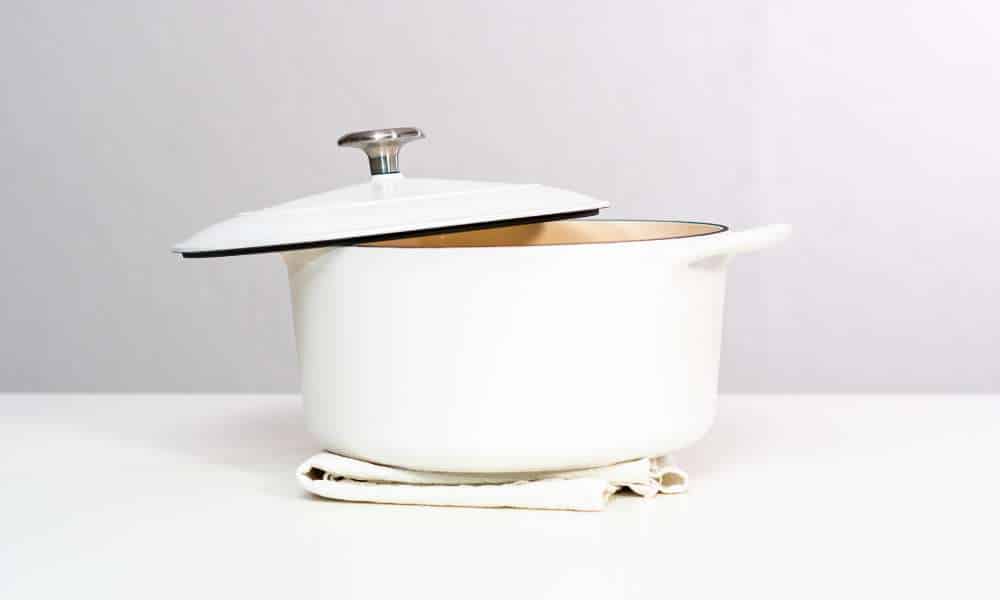Cast iron Dutch ovens are a kitchen favorite, prized for their durability and exceptional cooking performance. However, proper care is essential to maintain their quality, especially when it comes to cleaning. If you’ve ever wondered how to clean a cast iron Dutch oven, this guide is here to help. Cleaning cast iron requires specific techniques to preserve its seasoning and prevent rust. From removing stuck-on food to addressing rust spots, maintaining your Dutch oven ensures its longevity and keeps it ready for your next culinary creation. With simple steps and the right tools, you can keep your cast iron Dutch oven in pristine condition, making it a reliable companion in your kitchen for years to come.
Essential Tools and Supplies for Cleaning Cast Iron

Cleaning cast iron requires the right tools and supplies to maintain its integrity and seasoning. Start with a soft-bristled brush or non-abrasive scrubber to gently remove food residues without scratching the surface. Coarse kosher salt can act as a natural abrasive for tougher cleaning tasks, while a small amount of warm water helps loosen debris. Avoid soap or harsh detergents that can strip the seasoning. A microfiber cloth or paper towels are ideal for drying, ensuring no moisture is left to cause rust. Finally, a small amount of cooking oil keeps the cast iron conditioned and ready for future use. These essential tools ensure effective cleaning while preserving your cast iron’s quality.
Understanding the Seasoning Process and Its Role in Maintenance
The seasoning process is vital to maintaining your cast iron Dutch oven, as it creates a natural, non-stick coating that enhances cooking and protects the surface. Seasoning is achieved by applying a thin layer of oil and heating it until it bonds with the iron, forming a durable layer. This protective barrier prevents rust and improves the performance of your cookware. Regular use and proper cleaning preserve this seasoning, ensuring your Dutch oven remains functional and long-lasting. Avoid abrasive cleaning tools or harsh soaps that can strip the seasoning. Instead, use gentle methods to clean and reapply oil as needed to maintain its integrity and performance.
Step-by-Step Guide to Cleaning After Everyday Use
Cleaning your cast iron Dutch oven after everyday use is essential for maintaining its performance and longevity. Start by allowing the oven to cool completely to avoid thermal shock. Gently remove food residue using a soft scraper or sponge. Rinse with warm water—avoiding soap that can strip the seasoning. For stubborn bits, sprinkle coarse salt and scrub with a damp cloth. Once clean, dry thoroughly with a soft towel to prevent rust. Lightly coat the interior with a thin layer of cooking oil to maintain the seasoning. Store in a dry place with the lid slightly ajar to allow airflow. This simple routine keeps your Dutch oven ready for your next recipe.
How to Remove Burnt Food Without Damaging the Seasoning

Removing burnt food from a cast iron Dutch oven without damaging the seasoning requires a gentle yet effective approach. Start by adding warm water to the oven and letting it soak for a few minutes to loosen the residue. Use a non-abrasive scrubber or a wooden spatula to carefully lift the burnt food without scraping the surface. For tougher spots, sprinkle coarse salt into the oven and scrub lightly to remove the debris while preserving the seasoning. Avoid using soap or steel wool, as they can strip the protective layer. Rinse thoroughly, dry immediately, and apply a thin layer of oil to maintain the seasoning and keep your cast iron in top condition.
Dealing with Rust on Your Cast Iron Dutch Oven

Rust on your cast iron Dutch oven can be a common issue, but it’s manageable with the right approach. Start by gently scrubbing the affected area with a fine-grade steel wool or a stiff brush to remove surface rust. Rinse thoroughly with warm water and dry immediately to prevent further rusting. Once clean, re-season the Dutch oven by applying a thin layer of oil and heating it in the oven or stovetop. This process restores the protective coating and prevents rust from returning. Regular maintenance, proper drying, and storing in a dry place can help you keep your cast iron Dutch oven rust-free and in excellent condition for long-term use.
Using Salt Scrub for Gentle and Effective Cleaning
Using a salt scrub is a gentle and effective method for cleaning your cast iron Dutch oven without damaging the seasoning. How to season a cast iron Dutch oven is often the key concern, but using coarse salt helps maintain the seasoning while removing food residue. Simply pour the salt into the oven and scrub with a damp cloth or sponge, allowing the salt to lift stubborn bits. Rinse with warm water and dry thoroughly to avoid rust. This method preserves the non-stick surface and ensures your Dutch oven remains in top condition. Regular salt scrubbing helps keep your cast iron ready for every cooking adventure.
Avoiding Common Mistakes That Harm Cast Iron Surfaces
Protecting your cast iron Dutch oven requires avoiding common mistakes that can harm its surface. Never use soap or harsh detergents, as they can strip away the seasoning, reducing its non-stick properties. Avoid soaking the oven in water for extended periods, as this promotes rust formation. Using abrasive scrubbing tools, like steel wool, can scratch and damage the surface. Always dry your cast iron thoroughly after cleaning to prevent moisture-related issues. Failing to reapply a light coat of oil after washing can lead to a dull, unprotected surface. By steering clear of these mistakes, you can maintain the
Cleaning a Cast Iron Dutch Oven Without Soap or Chemicals

Cleaning a cast iron Dutch oven without soap or chemicals is a simple yet effective method to maintain its seasoning and enhance longevity. Start by using a wooden scraper or a soft-bristle brush to remove food particles. Sprinkle coarse salt into the oven as a natural abrasive, gently scrubbing to lift residue. Rinse with warm water, ensuring all debris is washed away, then wipe it dry immediately to prevent rust. For tougher spots, heat the oven slightly to loosen stuck-on food before scrubbing. This chemical-free cleaning approach not only preserves the non-stick surface but also ensures your Dutch oven stays in excellent condition for future use.
Tips for Drying and Storing Your Dutch Oven to Prevent Rust

Proper drying and storage are essential to prevent rust on your cast iron Dutch oven. After cleaning, dry the oven thoroughly with a soft cloth or towel to eliminate all moisture. For extra precaution, place it on low heat for a few minutes to ensure it is completely dry. Before storing, apply a thin layer of cooking oil to the surface, which helps maintain the seasoning and creates a protective barrier against rust. Store your Dutch oven in a cool, dry place with the lid slightly ajar to allow air circulation and avoid trapped moisture. Following these steps ensures your Dutch oven remains rust-free and ready for your next cooking adventure.
Restoring Lost Seasoning After Deep Cleaning
Restoring lost seasoning after deep cleaning your cast iron Dutch oven is crucial for maintaining its non-stick surface and durability. Start by thoroughly drying the oven to prevent rust. Apply a thin, even layer of cooking oil to the interior and exterior surfaces. Heat the Dutch oven in the oven or on the stovetop to allow the oil to bond with the metal, creating a protective layer. Repeat the process if necessary to build a strong seasoning. Avoid using excessive oil, as it can leave a sticky residue. With regular re-seasoning, your Dutch oven will remain in excellent condition, ready for all your favorite recipes and cooking adventures.
Conclusion
Learning how to clean a cast iron Dutch oven is key to preserving its functionality and charm. By following proper cleaning techniques—such as removing food residue with hot water, avoiding harsh soaps, and drying thoroughly—you can maintain the seasoning that makes cast iron cookware so versatile. Regular care prevents rust, enhances the non-stick surface, and extends the lifespan of your Dutch oven. Whether you’re tackling stubborn stains or re-seasoning after deep cleaning, these steps ensure your cast iron remains in perfect condition for years of use. Treat your Dutch oven with care, and it will continue to deliver exceptional performance, making it a reliable companion for all your cooking endeavors.

